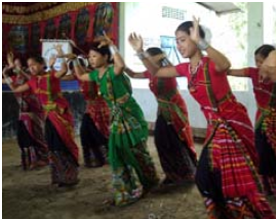About Mising Culture
 |
Traditional Festivals
Misings celebrate two agricultural festivals: one, named Ali-a:yé Lígang (Ali-a:yé pronounced as Aliyai in an assimilated form by some Mising speakers), which is celebrated annually in early spring (now uniformly on the first Wednesday of the month of Phagun according to the Indian calendar, which falls sometime in the third week of February); the other, named Po:rag, is a post-harvest festival, celebrated once in two to three years’ time or so after a winter harvest or a summer harvest.
Ali-A:yé Lígang
Ali:-A:yé Lígang marks the beginning of agricultural activities during a year. Ali: means ‘yam’ or yam-like underground roots, a:yé means ‘fruit’ or ‘grain’ (here seeds of crops) and Lígang means ‘beginning of sowing’. The celebrations commence with the ceremonial sowing of a small quantity of paddy seeds by the head of a family in the forenoon; the seeds are sown on a small patch of land, tilled with a hoe and marked by digging a variety of reed into its four corners, and prayers are offered to guardian spirits and ancestors for bountiful crops. Both feasting and merry-making on the occasion is a slightly low-key affair, especially when compared to what characterizes Po:rag. The feasting part of the celebrations includes the obligatory item of purang apin (a special kind of sticky rice, packed in leaves of a plant, resembling the wild cardamom, and boiled) on the menu and drinking of rice beer. Merrymaking in the form of singing and dancing by young men in the front yard of each household, called gumrag so:man, goes on in the evenings of the days of celebration. The rhythmic striking of a bell-metal gong, called lé:nong or marbang, to go with the playing of drums and cymbals at the time of the singing and dancing on the occasion, is a special feature of this festival, like the item of purang apin. Drumming too has a rhythm that is characteristic of gumrag so:man only. The festival, traditionally, is celebrated over a period of five days, the fourth day being a day of taboos such as prohibition on the digging of earth, the felling of trees, the eating of eggs, fruit, fried or sour items, fishing, making a fire in the fields, etc., violation being believed to prevent seeds of crops from sprouting and growing. The festival ends with feasts at home in the evening on the last day.
Po:rag
Po:rag is a feasting and merry-making extravaganza. As it is an expensive affair, it can be celebrated only after a good harvest. Preparations for the occasion too take some time, which is why it is not celebrated annually. The celebrations begin with prayers under the leadership of a Mibu, the medicine man (or, in the absence of Mibus these days, by an elderly person of the village, capable of leading prayers). Each and every member of the village community, young and old, is given a sumptuous treat on the occasion, pork being an obligatory item on the menu. There must also be plenty of po:ro apong (a rice beer of blackish colour, obtained by fermenting a mixture of undercooked rice and burnt chaff and straw) for everyone to drink. A very special feature of this festival is the invitation extended to all women of the
village married to men in other places. Such married couples are supposed to be accompanied by two or three youths, capable of singing or dancing. Prominent people from neighbouring villages and local dignitaries too are invited to join the feasting and merrymaking occasion. The celebrations go on usually for three days, and feasting and singing and
dancing too take place on all the three days.
Dobur
Dobur is an animistic rite observed occasionally in Mising villages at the community level. Four kinds of Dobur, viz. Burté Dobur, Mo:pun Dobur, Ko:son Dobur and Raban Ko:son, are observed by Misings living in different areas, of which the most common one is the Burté Dobur. It is observed when someone in the village commits a sin or an offence against some spirit, benevolent or malevolent, especially the latter, which causes, or might cause, great spirit, benevolent or malevolent, especially the latter, which causes, or might cause, great harm and suffering to individuals or the entire community. The sinner or the offender is made to incur a penalty in cash or kind, after which young men and boys beat the walls of every house in the village with sticks to drive away evil spirits lurking around in houses. The
participants in this exorcising activity then go to some spot, a little away from the village, sacrifice one or more sows and hens as offerings to spirits, and have a feast: the slaughter needs to be done by strangling. The spot, where the rite is performed, is considered a protected area on the day, and unwary passers-by trespassing the spot are required to pay a fine, failing which they have to leave behind an article or two in their possession that can be redeemed later by paying the fine. Mo:pun Dobur and Raban Ko:son relate to the appeasement of spirits for the protection of crops, sows and hens being sacrificed on this occasion also. Ko:son Dobur is observed by hunters to appease jungle spirits for success in hunts and prevention of harm that may be caused in the process: only hens are sacrificed on this occasion.
|